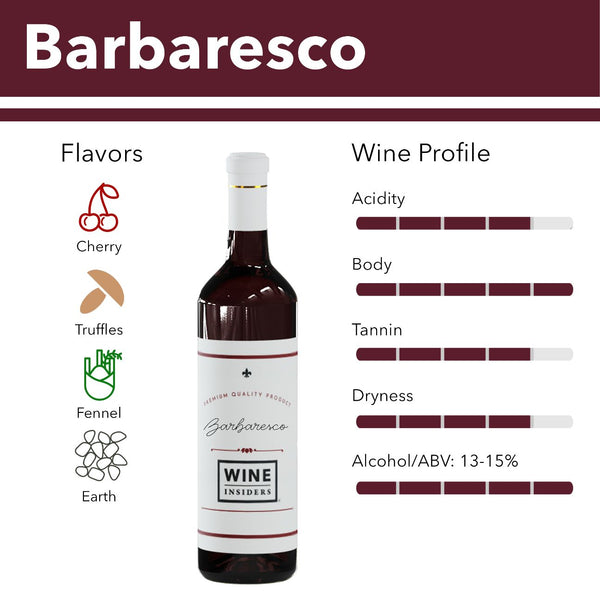Barbaresco
Barbaresco's full body pairs best with rich and hearty meals.
Barbaresco's full body pairs best with rich and hearty meals.

Bar-bar-ess-coe
Parents & Origin: Nebbiolo (indigenous, Northern Italy) Grape: Small, thin-skinned, glaucous, red Flavors: Cherry, truffles, fennel, licorice, smoke, earth Notable Regions: Piedmont, Italy (DOCG) Sweetness: Dry Body: Full Tannins: High Acidity: High ABV: 13-15%

Barbaresco is made from the nebbiolo grape, thought to be an indigenous varietal in Italy’s Piedmont region in its northwest. Nebbiolo has been used in winemaking since the 13th century, predominantly in making Barolo wine, which exploded in popularity in the mid-1800s after nebbiolo production was organized under Camillo Benso, Count of Cavour. Barolo still dominates the wine scene in Piedmont, but a related wine called Barbaresco emerged in the late 19th century that became an important variation in its own right.
The widely accepted birthdate of Barbaresco was in 1894, when the Cantina Sociale di Barbaresco was founded by Domizio Cavazza. Cavazza was an experienced winemaker and served as founding director of Alba's Royal Enological School in 1881, and after some time he developed a passion for the soils and terroir of Piedmont’s Barbaresco subregion. He and nine other winemakers formed an organization (the Cantina Sociale), purchased equipment, planted their Barbaresco vineyards with Nebbiolo grapes, and set to work.
Barbaresco went on to a strong start, effectively competing with Barolo for its first 10 to 20 years. Unfortunately, due to several phylloxera outbreaks and the devastation of World War I, most Barbaresco vineyards fell into ruin during the early 20th century. It was not until the 1950s, well after World War II, that producers began to make a sincere effort at making Barbaresco again. One family vineyard called Gaja became well-known in that decade, and a consortium of small producers was founded in 1958, similar to Cavazza’s original vision.
Since then, many Barbaresco landowners have returned to their vineyards and are now producing quality wine that has just begun to see international publicity. Pick up a bottle and experience one of Italy’s most overlooked yet most significant nebbiolo wines.
Interesting Fact: Like many Italian winemakers, Barbaresco producers sought to self-regulate and designate their industry into “crus,” similar to the regulated French crus of the Burgundy wine region. This task was accomplished in 2007 with the introduction of Menzioni Geografiche Aggiuntive (MEGA) subzones of the Barbaresco region, a useful tool to determine where a wine is coming from and which producers made it.
Barbaresco’s full body and intense flavors mean it pairs best with rich and hearty meals, similar to Barolo:
Barbaresco goes perfectly with rich, meat-focused dishes such as braised short ribs, beef roasts, lamb or veal chops. In these cases, the smoky and earthy qualities of the wine are complemented by the dish.
Like most tannic red wines, Barbaresco will overwhelm light dishes such as fish and chicken. Stick to red meats and rich vegetables to bring out the best in Barbaresco.

Per DOCG rules, Barbaresco must be aged for a minimum of 2 years (at least 9 months in oak) prior to release, and it must be aged for a minimum of 4 years to be considered gain Riserva designation.
Barbaresco must have at least 12.5% ABV, though most wines are closer to the 13-14 percent range. The wine demonstrates a vast aging potential, with many Barbarescos expected to age 5 to 10 years before they are consumed, as they are very tannic and bitter in their youth. On the nose, Barbaresco offers aromas of roses and violets, with flavor notes of cherry, truffles, fennel and licorice. When the wine has been aged for quite some time, it can develop smoky notes and more earthy flavors.
A big question that often emerges is how similar Barbaresco is to Barolo, its more popular cousin from the same grape. While both wines are quite similar and offer intrinsic nebbiolo flavors, there are some significant differences, despite each wine being produced only 10 miles from one another.
The Barbaresco climate has a slight maritime influence from the river Tanaro, meaning that the grapes ripen earlier and allow for a shorter maceration time and a less tannic composition. To the wine enthusiast, the main difference is that Barbaresco is more suited for drinking young due to its greater fruit notes and low degree of harshness compared to unaged Barolo. Barbaresco is also a more consistent product due to the very small region it occupies.
Barbaresco is known as a very age-friendly wine due to its high tannins which soften significantly over a period of aging in both barrel and bottle. DOCG regulations require a minimum of two years of aging to be labeled Barbaresco, with 4 years required for Riserva Barbaresco. This requirement is lower than the even more tannic Barolo (3 and 5 years respectively), but at least a few years of aging are generally recommended to soften the tannins before consumption.
Since its early origins, Barbaresco has flown under the radar of its popular Barolo sibling. Nonetheless, it has endured as one of Italy’s most beloved takes on the Nebbiolo grape, offering a classic floral aroma along with flavors of cherry, truffle, fennel, and licorice. Barbaresco is sure to impress in any situation, especially if it has been aged for some years to soften its bite and bring out the subtle notes of smoke and earth. A bottle of Barbaresco is the perfect complement to rich meats, making it a delicious option for any Italian wine aficionado.
There's nothing in your cart yet.
Shop All Wines